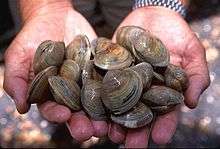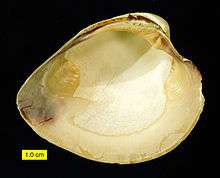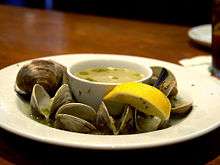Hard clam
The hard clam (Mercenaria mercenaria), also known as a quahog (/ˈk(w)oʊhɒɡ/; or quahaug), round clam or hard-shell (or hard-shelled) clam, is an edible marine bivalve mollusk that is native to the eastern shores of North America and Central America from Prince Edward Island to the Yucatán Peninsula. It is one of many unrelated edible bivalves that in the United States are frequently referred to simply as clams, as in the expression "clam digging". Older literature sources may use the systematic name Venus mercenaria; this species is in the family Veneridae, the venus clams.
| Hard clam | |
|---|---|
 | |
| Scientific classification | |
| Kingdom: | Animalia |
| Phylum: | Mollusca |
| Class: | Bivalvia |
| Subclass: | Heterodonta |
| Order: | Venerida |
| Superfamily: | Veneroidea |
| Family: | Veneridae |
| Genus: | Mercenaria |
| Species: | M. mercenaria |
| Binomial name | |
| Mercenaria mercenaria | |
Confusingly, the "ocean quahog" is a different species, Arctica islandica, which, although superficially similar in shape, is in a different family of bivalves: it is rounder than the hard clam, usually has black periostracum, and there is no pallial sinus in the interior of the shell.
Alternative names

The hard clam has many alternative common names. It is also known as the Northern quahog, round clam, or chowder clam.[1]
In fish markets, there are specialist names for different sizes of this species of clam. The smallest legally harvestable clams are called countnecks or peanuts, next size up are littlenecks, then topnecks. Above that are the cherrystones, and the largest are called quahogs or chowder clams.[2]
The most distinctive of these names is quahog (/ˈkoʊhɒɡ/ KOH-hog, /ˈkwɔːhɒɡ/ KWAW-hog, or /kwəˈhɒɡ/ kwə-HOG). The word comes from the Narragansett word "poquauhock", which is similar in Wampanoag and some other Algonquian languages; it is first attested in North American English in 1794.[3][4] New England tribes made valuable beads called wampum from the shells, especially those colored purple; the species name mercenaria is related to the Latin word for commerce. Today people living in coastal New England still use the Native American word for the clam as they have done for hundreds of years.
In many areas where aquaculture is important, clam farmers have bred specialized versions of these clams with distinctions needed for them to be distinguished in the marketplace. These are quite similar to common "wild type" Mercenaria clams, except that their shells bear distinctive markings. These are known as the notata strain of quahogs, which occur naturally in low numbers wherever quahogs are found.[5]
Distribution
Hard clams are quite common throughout New England, north into Canada, and all down the Eastern seaboard of the United States to Florida; but they are particularly abundant between Cape Cod and New Jersey, where seeding and harvesting them is an important commercial form of aquaculture. For example, the species is an important member of the suspension-feeding, benthic fauna of the lower Chesapeake Bay.
Rhode Island is situated right in the middle of "quahog country" and has supplied a quarter of the U.S.'s total annual commercial quahog catch. The quahog is the official shellfish of the U.S. state of Rhode Island. The species has also been introduced and is farmed on the Pacific coast of North America and in Great Britain and continental Europe. It reproduces sexually by females and males shedding gametes into the water.[2]
Parasite
Quahog parasite unknown (QPX)[6] is a parasite that affects Mercenaria mercenaria. While little is known about the disease, research is currently under way in several laboratories.[7] This research is fueled by the need to inform aquaculturists, who suffer financially because of the mortality rates in clams that QPX inflicts and the ensuing years in which runs must be left fallow to clear the disease. It was discovered along the coast of Cape Cod, Massachusetts in 1995.
Human use

In coastal areas of New England, New York, and New Jersey, restaurants known as raw bars or clam bars specialize in serving littlenecks and topnecks raw on an opened half-shell, usually with a cocktail sauce with horseradish, and often with lemon. Sometimes littlenecks are steamed and dipped in butter, though not as commonly as their soft-shelled clam cousin the "steamer". Littlenecks are often found in-the-shell in sauces, soups, stews, and clams casino, or substituted for European varieties such as the cockle in southern European seafood dishes. The largest clams are quahogs or chowders and cherrystones; they have the toughest meat and are used in such dishes as clam chowder, clam cakes, and stuffed clams, or are minced and mixed into dishes that use the smaller, more tender clams.
Historically, American Indians used the quahog as a component in wampum, the shell beads exchanged in the North American fur trade.[8] The Narragansetts used the hard clam for food and ornaments.[9]
A population of hard clams exists in Southampton Water in Hampshire, England. Originally bred in the warm water outflows at Southampton Power Station for use as eel bait, the population became self-sustaining and can now be found in Southampton Water and has also spread to Portsmouth Harbour and Langstone Harbour.
Clams and red tide
The term "red tide" refers to an accumulation of a toxin, such as saxitoxin, produced by marine algae.[10][11] Filter-feeding shellfish are affected, such as clams, oysters, and mussels.[10][11] The toxin affects the human central nervous system.[10] Eating contaminated shellfish, raw or cooked, can be fatal.[10] Some other kinds of algal blooms make the seawater appear red, but red tide blooms do not always discolor the water, nor are they related to tides.[10]
Reproductive biology
Mercenaria mercenaria has an external mode of fertilization by extrusion of the acrosome filament, occurring in the process of sperm penetration through the egg investment in the mollusk.[12][13]
References
- Harte, M. E. 2001. "Systematics and taxonomy, Chapter 1", pp. 3–51, in Kraeuter, J. N. and M. Castagna (eds.) "Biology of the Hard Clam", Developments in Aquaculture and Fisheries Science, Vol. 31. Elsevier Science B.V.: New York.
- Rice, M.A. (1992). The Northern Quahog: Biology of Mercenaria mercenaria. Rhode Island Sea Grant Publication No. RIU-B-92-001, University of Rhode Island, Narragansett. 60 pp. ISBN 0-938412-33-7 web link.
- "Quahaug, quahog", in Shorter Oxford English Dictionary, 3rd ed (Oxford: Clarendon Press, 1973)
- Roger Williams, A Key Into the Language of America. London: Gregory Dexter, 1643.
- Eldridge, P.J., W. Waltz, and H. Mills. 1975. Relative abundance of Mercenaria mercenaria notata in estuaries of South Carolina. Veliger 18:396-397.
- "QPX". Marine Symbiosis.
- Calvo, LMR; Ford, S. E.; Kraeuter, J. N.; Leavitt, D. F.; Smolowitz, R.; Burreson, E. M. (1 January 2007). "Influence Of Host Genetic Origin And Geographic Location On Qpx Disease In Northern Quahogs (=Hard Clams), Mercenaria Mercenaria". Journal of Shellfish Research. 26: 109–119. doi:10.2983/0730-8000(2007)26[109:IOHGOA]2.0.CO;2.
- White, Richard (1991). The Middle Ground: Indians, Empires, and Republics in the Great Lakes Region, 1650–1815 (2nd ed.). New York: Cambridge University Press. p. 97. ISBN 9781139495684. OCLC 772696326.
- Feeney, Kathy (2003). Rhode Island Facts and Symbols. Albert T. Klyberg (consultant) (Revised and Updated ed.). Mankato, Minn.: Capstone Press. pp. 18–19. ISBN 9780736822701. OCLC 51204649.
- "Paralytic Shellfish Poisoning". Washington State Department of Health. 2020. Retrieved 10 August 2020.
- "Paralytic Shellfish Poisoning". Centre for Disease Control, British Columbia Health Services Authority. 2020. Retrieved 10 August 2020.
- Eversole, A. G. (2001). Reproduction in Mercenaria mercenaria, Chapter 5. In Kraeuter, J. N. and Castagna, M. (eds.) Biology of the Hard Clam. New York: Elsevier Science B.V. pp. 221–260. ISBN 0-444-81908-8.
- Ying, Xue-Ping; Yang, Wang-Xi; Dahms, Hans-U; Lin, Zhihua; Chai, Xueliang (2008). "Spermatozoa and spermatogenesis in the northern quahaug Mercenaria mercenaria (Mollusca, Bivalvia)". Helgoland Marine Research. 62: 321–329. doi:10.1007/s10152-008-0119-6.